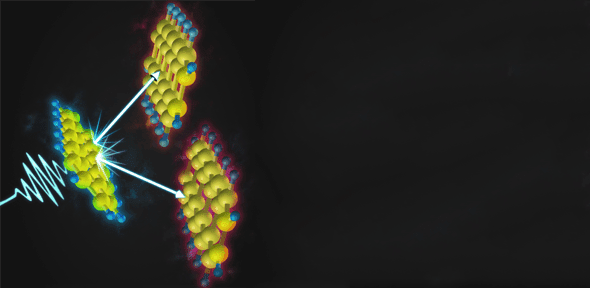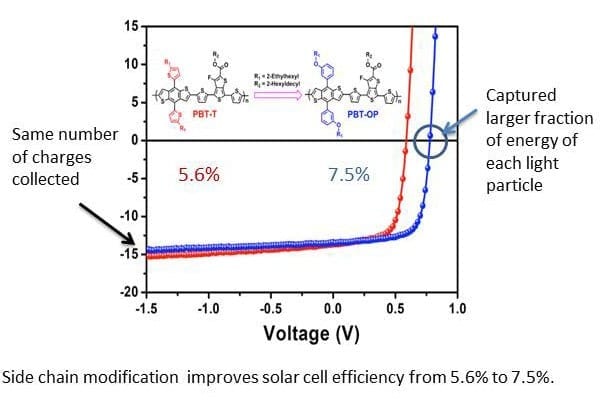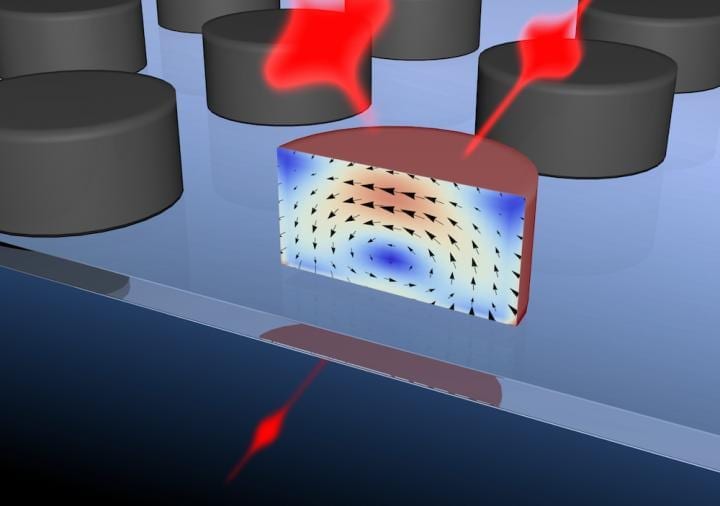Harnessing the process of singlet fission into new solar cell technologies could allow tremendous increases in energy conversion efficiencies in solar cells
Alex Chin
An international team of scientists have observed how a mysterious quantum phenomenon in organic molecules takes place in real time, which could aid in the development of highly efficient solar cells.
The researchers, led by the University of Cambridge, used ultrafast laser pulses to observe how a single particle of light, or photon, can be converted into two energetically excited particles, known as spin-triplet excitons, through a process called singlet fission. If singlet fission can be controlled, it could enable solar cells to double the amount of electrical current that can be extracted.
In conventional semiconductors such as silicon, when one photon is absorbed it leads to the formation of one free electron that can be harvested as electrical current. However certain materials undergo singlet fission instead, where the absorption of a photon leads to the formation of two spin-triplet excitons.
Working with researchers from the Netherlands, Germany and Sweden, the Cambridge team confirmed that this ‘two-for-one’ transformation involves an elusive intermediate state in which the two triplet excitons are ‘entangled’, a feature of quantum theory that causes the properties of each exciton to be intrinsically linked to that of its partner.
By shining ultrafast laser pulses – just a few quadrillionths of a second – on a sample of pentacene, an organic material which undergoes singlet fission, the researchers were able to directly observe this entangled state for the first time, and showed how molecular vibrations make it both detectable and drive its creation through quantum dynamics. The results are reported today (26 October) in the journal Nature Chemistry.
“Harnessing the process of singlet fission into new solar cell technologies could allow tremendous increases in energy conversion efficiencies in solar cells,” said Dr Alex Chin from the University’s Cavendish Laboratory, one of the study’s co-authors. “But before we can do that, we need to understand how exciton fission happens at the microscopic level. This is the basic requirement for controlling this fascinating process.”
The key challenge for observing real-time singlet fission is that the entangled spin-triplet excitons are essentially ‘dark’ to almost all optical probes, meaning they cannot be directly created or destroyed by light. In materials like pentacene, the first stage – which can be seen – is the absorption of light that creates a single, high-energy exciton, known as a spin singlet exciton. The subsequent fission of the singlet exciton into two less energetic triplet excitons gives the process its name, but the ability to see what is going on vanishes as the process take place.
To get around this, the team employed a powerful technique known as two-dimensional spectroscopy, which involves hitting the material with a co-ordinated sequence of ultrashort laser pulses and then measuring the light emitted by the excited sample. By varying the time between the pulses in the sequence, it is possible to follow in real time how energy absorbed by previous pulses is transferred and transformed into different states.
Using this approach, the team found that when the pentacene molecules were vibrated by the laser pulses, certain changes in the molecular shapes cause the triplet pair to become briefly light-absorbing, and therefore detectable by later pulses. By carefully filtering out all but these frequencies, a weak but unmistakable signal from the triplet pair state became apparent.
The authors then developed a model which showed that when the molecules are vibrating, they possess new quantum states that simultaneously have the properties of both the light-absorbing singlet exciton and the dark triplet pairs. These quantum ‘super positions’, which are the basis of Schrödinger’s famous thought experiment in which a cat is – according to quantum theory – in a state of being both alive and dead at the same time, not only make the triplet pairs visible, they also allow fission to occur directly from the moment light is absorbed.
Read more: Entanglement at heart of ‘two-for-one’ fission in next-generation solar cells
The Latest on: Singlet fission
[google_news title=”” keyword=”singlet fission” num_posts=”10″ blurb_length=”0″ show_thumb=”left”]
via Google News
The Latest on: Singlet fission
- Illuminating antiaromaticityon April 29, 2024 at 12:50 am
Aromaticity's dark alter-ego is ready to emerge into the sunlight. James Mitchell Crow talks to the scientists trying to exploit the instability ...
- Fission Announces New Exploration and Resource Drill Programs at PLS High-Grade Uranium Projecton April 7, 2024 at 8:00 pm
Regional exploration and R1515W zone drilling to carried out concurrently KELOWNA, BC, April 8, 2024 /CNW/ - FISSION URANIUM CORP. ("Fission" or the "Company") is pleased to announce that ...
- Fission Commencing Geotechnical Drilling in Advance of Detailed Engineeringon April 1, 2024 at 8:00 pm
KELOWNA, BC, April 2, 2024 /CNW/ - FISSION URANIUM CORP. ("Fission" or "the Company") is pleased to announce it is about to commence geotechnical drilling at its PLS high-grade uranium mine and ...
- Frank Ocean looking jacked in a wrestling singlet has Gay Twitter™ in a headlockon March 5, 2024 at 11:25 am
On Monday, Ocean showed off his physical transformation by sharing a mirror selfie rocking a wrestling singlet that left little to the imagination. Sign up for the Queerty newsletter to get your ...
- Long-Overdue Praise for the Running Singleton March 4, 2024 at 9:55 am
In the last decade, the running singlet—once reserved for amateur competitors and professional athletes—has gone mainstream not only on race day but also on everyday runs. Apparel brands like ...
- Fusion - Frequently asked questionson October 28, 2023 at 3:25 am
Its two sources of fuel, hydrogen and lithium, are widely available in many parts of the Earth. What’s the difference between nuclear fission and nuclear fusion? Both are nuclear processes, in that ...
- The Integral Molten Salt Reactor And The Benefits Of Having A Liquid Fission Reactoron June 7, 2023 at 2:23 am
Although to most the term ‘fission reactor’ brings to mind something close to the commonly operated light-water reactors (LWRs) which operate using plain water (H 2 O) as coolant and with ...
- A New Approach to Regulate Single Fission Developedon March 23, 2023 at 5:00 pm
Tokyo Tech and Keio University scientists show a new method to manage singlet fission (SF) by applying hydrostatic pressure as an external stimulus. This is a method in which two electrons are ...
- Ayan Dattaon December 6, 2022 at 7:19 am
As an independent research PI, I have studied structure and electronic properties of low-dimensional materials for energy storage and catalysis and optical properties of organic molecules for Singlet ...
- Professor Jenny Clarkon December 14, 2018 at 11:14 pm
The splitting process is known as singlet exciton fission. The ability to generate two excited states from one photon could be used in solar cells to dramatically improve their efficiency. The fission ...
via Bing News










